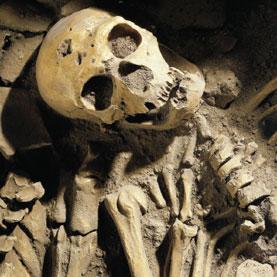Kate Wong
Source - http://www.scientificamerican.com/article/new-evidence-suggest-neandertals-buried-their-dead/

Around 60,000 years ago, in a small limestone cave in what is now central France, Neandertals dug a grave and laid an elderly member of their clan to rest. That is the picture emerging from the archaeological site that yielded the famous La Chapelle-aux-Saints Neandertal skeleton in 1908, and it has important implications for understanding the behavior and cognitive capacity of our closest evolutionary relatives.
Some archaeologists have long argued that a number of Neandertal sites preserve evidence of burials, a practice considered to be a key feature of modern human behavior. But critics have countered that the sites were excavated long ago using outmoded techniques that obscure the facts.
In recent years researchers have found compelling evidence that Neandertals had other modern practices, such as decorating their bodies and making sophisticated tools. They did such things before anatomically modern humans invaded their turf, suggesting that Neandertals developed cultural traditions independently, rather than learning them from savvy newcomers.
A reexcavation of the French cave has recovered more Neandertal bones and teeth, as well as stone tools and animal remains. William Rendu of New York University and his colleagues found a number of features indicating that the pit containing the Neandertal skeleton was at least partially modified for the purposes of burial, as opposed to being an entirely natural depression. They also observed that whereas the animal remains appear to have been gnawed on by carnivores, the Neandertal bones exhibit no such damage, suggesting that the corpse was covered rapidly, as would occur if it were intentionally buried. Rendu and his colleagues reported their findings in January in theProceedings of the National Academy of Sciences USA.
Ironically, the original La Chapelle-aux-Saints discovery in the early 20th century gave rise to the Neandertals' unfortunate reputation as dumb brutes. Shortly after the find, French paleontologist Marcellin Boule reconstructed the skeleton to show a stooped, slouching individual with bent knees, a short neck and a low, sloping skull. Thus, the image of the oafish caveman was born. Scientists later determined that the skeleton was in fact that of an aged male who suffered from severe arthritis.